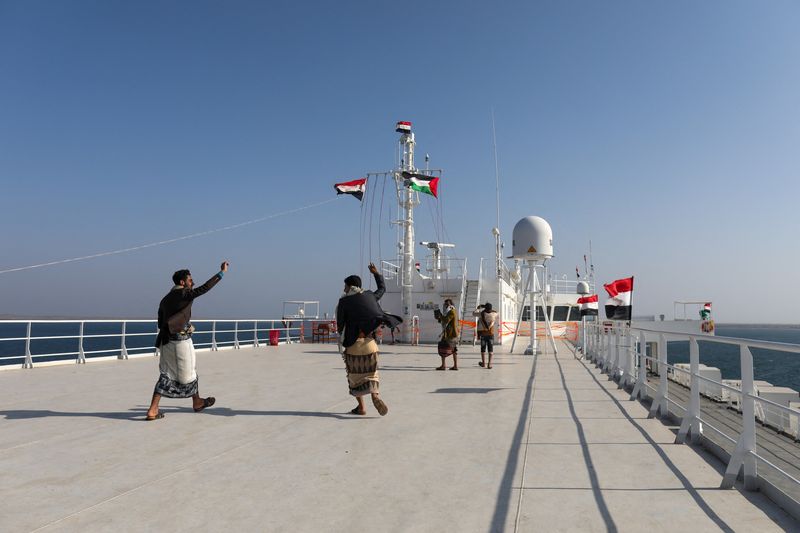By Ahmad Ghaddar
LONDON (Reuters) - Yemen's Houthis have been targeting vessels in the southern Red Sea and the Bab al-Mandab Strait in attacks that the Iran-aligned group says aim to support the Palestinians as Israel and Hamas wage war.
Danish shipping company Maersk said on Thursday its ship Maersk Gibraltar was targeted by a missile while travelling from Oman to Saudi Arabia, but it subsequently denied that it was hit. The Houthis had claimed responsibility for a drone strike against the tanker.
WHAT ARE THE RECENT HOUTHI ATTACKS?
* Dec. 15: A projectile launched from Houthi-controlled Yemen strikes the Liberia-flagged, German-owned, Al Jasrah ship, causing a fire but no injuries, a U.S. defence official says.
* Dec. 15: Maersk denies a claim by the Houthi movement that the militia carried out a drone strike on a Maersk vessel sailing towards Israel, but says the tanker was targeted by a missile. Shipping sources said on Thursday that Maersk Tankers vessels have the option to re-route via the Cape of Good Hope due to the worsening security situation in the Red Sea.
* Dec. 12: Houthi spokesman says the group targeted the Norwegian commercial tanker STRINDA. The attack took place about 60 nautical miles (111 km) north of the Bab al-Mandab Strait at about 2100 GMT, a U.S. official tells Reuters.
* Dec. 9: Houthis warn they will target all ships heading to Israel, regardless of their nationality, and warn all international shipping companies against dealing with Israeli ports.
* Dec. 3: The U.S. military says three commercial vessels came under attack in international waters in the southern Red Sea, as Houthis claimed drone and missile attacks on two Israeli vessels in the area.
* Nov. 19: Israel says Houthis seized a British-owned and Japanese-operated cargo ship in the southern Red Sea.
WHAT IS THE BAB AL-MANDAB?
* Bab al-Mandab, or the Gate of Tears, named for its perilous navigation, is the southern outlet of the Red Sea, between Yemen on the Arabian Peninsula and Djibouti and Eritrea on the African coast.
* It is one of the world's most important routes for global seaborne commodity shipments, particularly crude oil and fuel from the Gulf bound for the Mediterranean via the Suez Canal or SUMED pipeline, as well as commodities bound for Asia, including Russian oil.
* The Bab al-Mandab was the site of a naval blockade of Israel by Egypt in the 1973 Yom Kippur War.
* The Bab al-Mandab is 18 miles wide at its narrowest point, making tanker traffic difficult and limited to two channels for inbound and outbound shipments, divided by the island of Perim.
* Around 7.80 million barrels per day of crude and fuel shipments transited the strait in the first 11 months of 2023, up from 6.60 million bpd throughout 2022, according to oil analytics firm Vortexa. On average, Vortexa tracked 27 tankers carrying crude or fuel each day in 2023, up from 20 last year.
* According to the Energy Information Administration, 12% of total seaborne-traded oil in the first half of 2023 as well as 8% of LNG trade passed through Bab al-Mandab, the SUMED pipeline and the Suez Canal.
NAVAL PROTECTION?
* The U.S. Special Envoy for Yemen, Tim Lenderking, told Reuters on Thursday that Washington wanted the "broadest possible" maritime coalition to protect ships in the Red Sea, and signal to the Houthis that attacks would not be tolerated.
* Sources told Reuters, however, that Saudi Arabia - seeking to contain spillover from the Hamas-Israel war - has asked the United States to show restraint in responding to attacks in the Red Sea.
* The international community has had a history of using naval forces to protect navigation from piracy off the Horn of Africa, especially as Somali piracy surged in the 2005-2011 period.

* In Dec. 2008, the European Union launched "Operation Atalanta" to tackle attacks by Somali pirates on cargo ships. NATO's Operation Ocean Shield as well as a multinational naval force known as Combined Task Force 151 have also been involved in anti-piracy protection.
Sources: Reuters, Energy Information Administration, Vortexa, World Bank